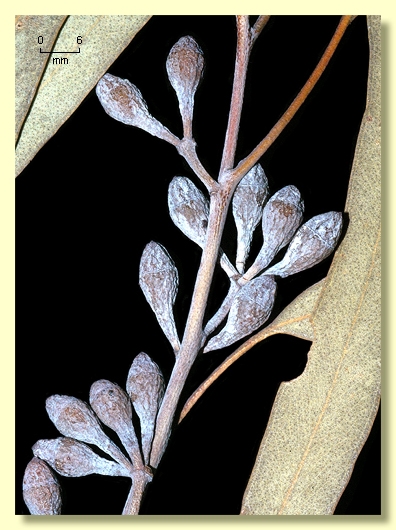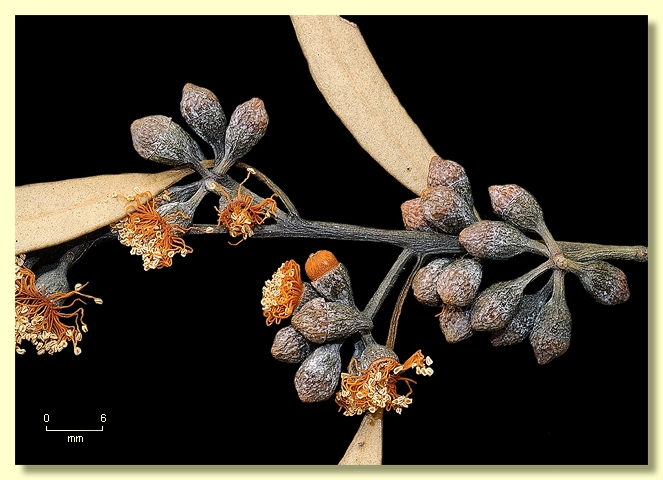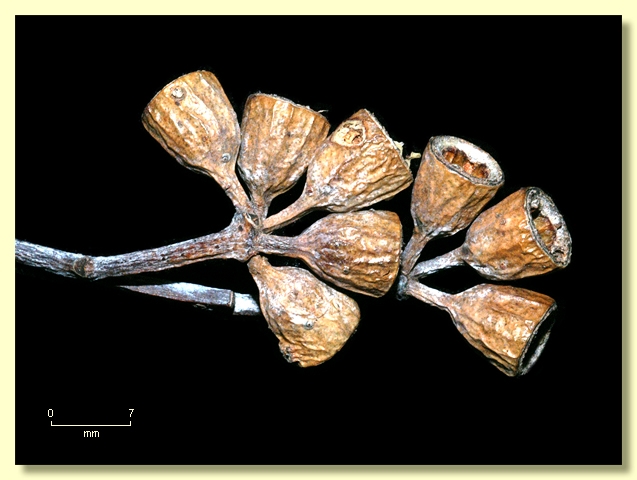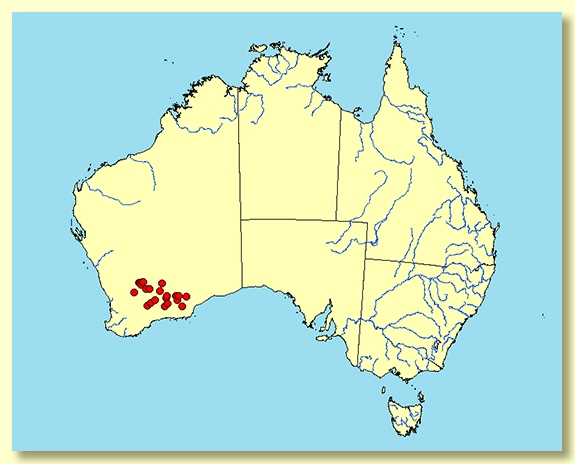Eucalyptus | Symphyomyrtus | Dumaria | Rufispermae
Euclid - Online edition
Eucalyptus vittata
Mallet to 14 m tall. Lignotuber absent.
Bark smooth throughout, grey and creamy white over yellow, tan or pale salmon, shedding in conspicuous long ribbons.
Branchlets glaucous; oil glands present in the pith.
Juvenile growth (coppice or field seedlings to 50 cm): not seen.
Adult leaves alternate, petioles 1.1–2.5 cm long; blade lanceolate, 7-15 cm long, 0.7–2.3 cm wide, base tapering to petiole, margin entire, apex acute, concolorous, dull, blue-green to green, side veins acute, reticulation dense to very dense, intramarginal vein close to margin, oil glands intersectional and a few island.
Inflorescence axillary unbranched, peduncles 0.5–1.3 cm long, buds 7 or 9 per umbel, pedicellate, pedicels 0.1–0.6 cm long. Mature buds obovoid to pyriform, less commonly cylindrical (0.7–1 cm long, 0.4–0.6 cm wide), glaucous or not, scar present (outer operculum sheds very early), operculum usually conical, often weakly radially striate, stamens inflexed, cuboid to wedge shaped versatile anthers, sub-dorsifixed, dehiscing by longitudinal slits, style long and straight, stigma rounded to tapering, locules 4, the placentae each with 4 vertical rows of ovules. Flowers creamy white.
Fruit pedicellate, pedicels 0.1–0.6 cm long, hemispherical to cylindrical or cupular, rarely slightly campanulate, 0.5–0.7 cm long, 0.5–0.8 cm wide, glaucous or weathering non-glaucous, not ridged, disc usually descending vertically, valves 4, near rim level.
Seeds reddish-brown and glossy, 1.5–2 mm long, flattened-ovoid and sometimes slightly angular in outline, dorsal surface shallowly reticulate, hilum ventral.
Cultivated seedlings (measured at ca node 10): cotyledons reniform; stems square or rounded in cross-section, glaucous, slightly warty or smooth; leaves always petiolate, alternate after 3 to 4 nodes, ovate, 3.8–6.7 cm long, 2.2–4.5 cm wide, glaucous over grey-green.
Flowering has been recorded in January and March.
A woodland mallet species endemic to the Goldfields region of southern Western Australia occurring in the Norseman – Coolgardie area extending from the Fraser Range west to Lake Deborah near Koolyanobbing and south to Varley. It is found on flat sites with calcareous sandy loams or sandy clay soils. Eucalyptus vittata is completely smooth-barked and has a dull-leaved crown, and commonly has waxy branchlets, buds and young fruits. When the bark sheds in spring it hangs in conspicuous streamers often from the crown to the ground.
In the classification of Brooker (2000) the more recently published Eucalyptus vittata would belong in Eucalyptus subgenus Symphyomyrtus section Dumaria having these features: buds initially with two opercula the outer shed early, stamens strongly inflexed, ovules in 4 rows on each placenta and cotyledons reniform. Within section Dumaria the species belongs to a large sub-group of closely related species (series Rufispermae, 37 described species and subspecies) diagnosed by glandular pith in the branchlets, cuboid-wedge shaped versatile anthers, and by the reddish brown and glossy, flattish seeds which are unique to the series.
Within the natural range of E. vittata there are many woodland mallet species belonging to a variety of taxonomic groups within Eucalyptus. E. vittata can be distinguished from all by the combination of smooth bark, general waxiness, glandular pith of the branchlets, dull crown leaves and small unribbed fruit. In this Goldfields area there is a diversity of smooth-barked mallet species in series Rufispermae alone, the species differing from E. vittata thus: E. georgei subsp. georgei differs in its broader dull leaves and conspicuously larger buds and fruit, whilst E. georgei subsp. fulgida has broad glossy adult leaves; E. distuberosa has similar sized but shallowly ribbed buds and fruit (cf. E. vittata), glossy leaves, and is never white waxy; E. tenuis, E. pterocarpa and E. frenchiana all have larger and manifestly ribbed buds and fruit, glossy leaves and lack waxiness; E. fraseri subsp. fraseri has larger buds and fruit that are sessile or almost so and lacks waxiness; while E. spreta and E. polita are non-waxy, glossy-leaved and have slightly smaller buds and fruit than does E. vittata.
E. vittata was formerly included under the name E. sheathiana but in 2009 was described as being a different species. E. sheathiana differs from E. vittata in having a lignotuber and is almost always multistemmed, i.e. has a mallee habit; it occurs in the southern wheatbelt, an area with higher and more reliable rainfall than the adjacent Goldfields area, but, like E. vittata, it prefers flattish sites with sandy loam soils. In all features other than the presence/absence of a lignotuber the two species are virtually identical. Trees can sometimes be found growing near or among mallee stands of E. sheathiana and are presumably of that species but checking to see if they develop lignotubers is the only way to be certain.
Trees about 10 m tall found from the Merredin and Kellerberrin area have fruit slightly longer than wide (0.8-0.9 cm long, 0.6-0.7 cm wide) and longer peduncles (more than 1.5 cm long), compared with typical Goldfields E. vittata. The lignotuber status of these plants is unknown, and they are excluded from the above description, as they may represent intermediates with a more northerly taxon E. obtusiflora subsp. cowcowensis .
[It is worth noting that Nicolle (2009) seems to have arbitrarily decided that Eucalyptus sheathiana Maiden is a species that is always lignotuberous and of predominantly mallee habit. E. sheathiana was originally described in 1916 from a cultivated plant in Kings Park, Perth, grown in 1911 from seed received from the "Eastern Goldfields" with no information about the growth habit of the wild parent. E. sheathiana has been referred to throughout the last ca 100 years as: both a tree and a mallee by Maiden (1916), a slender tree (Blakely, 1934), tree or a mallee (Chippendale, 1973), mallee or small tree (Brooker & Kleinig, 1990), tree or mallee, with or without lignotuber (Brooker et al, EUCLID edition 2, 2002). There is also reference to the possibility of E. sheathiana lacking a lignotuber by Blakely (1934) assigining the common name "Sheath's Gum or Marlock", with Blakely using the term "marlock" to mean "dwarf species of Eucalyptus with a reduced rootstock". Nicolle's decision and subsequent description of the mallet as a new species, E. vittata, from the Goldfields, solves the problem of two taxa masquerading under the name E. sheathiana, but the decision could, just as validly, have been reversed, with the new species being the lignotuberous plant.]
Eucalyptus vittata: Latin vittatus meaning bound with a ribbon, a reference to the streamers of shed bark hanging from the crown in springtime (Nicolle, 2009)










